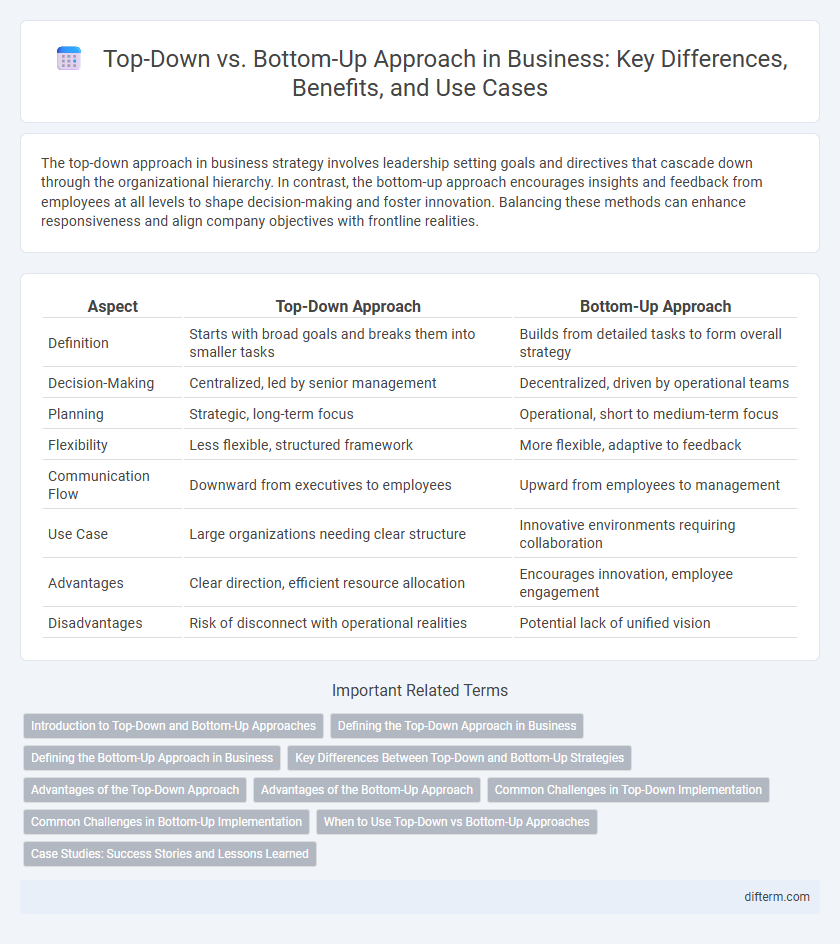The top-down approach in business strategy involves leadership setting goals and directives that cascade down through the organizational hierarchy. In contrast, the bottom-up approach encourages insights and feedback from employees at all levels to shape decision-making and foster innovation. Balancing these methods can enhance responsiveness and align company objectives with frontline realities.
Table of Comparison
| Aspect | Top-Down Approach | Bottom-Up Approach |
|---|---|---|
| Definition | Starts with broad goals and breaks them into smaller tasks | Builds from detailed tasks to form overall strategy |
| Decision-Making | Centralized, led by senior management | Decentralized, driven by operational teams |
| Planning | Strategic, long-term focus | Operational, short to medium-term focus |
| Flexibility | Less flexible, structured framework | More flexible, adaptive to feedback |
| Communication Flow | Downward from executives to employees | Upward from employees to management |
| Use Case | Large organizations needing clear structure | Innovative environments requiring collaboration |
| Advantages | Clear direction, efficient resource allocation | Encourages innovation, employee engagement |
| Disadvantages | Risk of disconnect with operational realities | Potential lack of unified vision |
Introduction to Top-Down and Bottom-Up Approaches
Top-down and bottom-up approaches represent distinct methodologies in business strategy and decision-making. The top-down approach starts with senior management setting goals and directives that filter down through the organization, ensuring alignment with corporate vision. Conversely, the bottom-up approach emphasizes input and innovation from employees at all levels, fostering collaboration and responsiveness to operational challenges.
Defining the Top-Down Approach in Business
The top-down approach in business involves senior management setting strategic goals and directives that cascade down through organizational levels for implementation. This method emphasizes centralized decision-making, ensuring alignment with the company's vision and streamlined control over resource allocation. It is often used in large corporations to maintain consistency and focus across departments.
Defining the Bottom-Up Approach in Business
The bottom-up approach in business emphasizes decision-making driven by input from lower organizational levels, empowering employees to contribute ideas and solutions. This strategy fosters innovation and responsiveness by leveraging detailed insights from frontline operations and customer interactions. Companies utilizing bottom-up methods often see increased engagement and more adaptable, data-informed decisions that align closely with market needs.
Key Differences Between Top-Down and Bottom-Up Strategies
Top-down and bottom-up strategies differ primarily in decision-making processes and implementation direction; top-down approaches centralize control with leadership setting objectives, while bottom-up strategies emphasize employee input and grassroots innovation. Top-down strategies often ensure uniformity and quick execution, whereas bottom-up methods foster collaboration and adaptability. Key differences also include communication flow, with top-down being vertical and directive, and bottom-up promoting horizontal feedback and empowerment.
Advantages of the Top-Down Approach
The top-down approach streamlines decision-making by providing clear strategic direction from senior management, ensuring alignment with organizational goals. It enables efficient resource allocation and faster implementation of initiatives due to centralized control. This method also facilitates consistent communication and accountability across all departments, reducing ambiguity in responsibility.
Advantages of the Bottom-Up Approach
The bottom-up approach empowers employees at all levels to contribute insights and solutions, fostering innovation and increasing engagement within the organization. This method enhances accuracy in decision-making by leveraging comprehensive, ground-level data and practical experiences. Businesses adopting bottom-up strategies often experience improved adaptability and more effective problem-solving in dynamic markets.
Common Challenges in Top-Down Implementation
Common challenges in top-down implementation include resistance from lower-level employees due to perceived lack of involvement and ownership. Communication gaps often arise as directives flow downward, leading to misalignment with operational realities. Limited feedback loops can hinder adaptability and cause delays in identifying and resolving execution problems.
Common Challenges in Bottom-Up Implementation
Bottom-up implementation faces common challenges such as fragmented decision-making, which can lead to inconsistencies and misalignment with overall business strategy. Limited visibility into grassroots initiatives often hinders executive oversight and resource allocation. Resistance from middle management may slow progress as conflicting priorities emerge between operational teams and leadership goals.
When to Use Top-Down vs Bottom-Up Approaches
Top-down approach is most effective when quick decision-making and clear strategic alignment from leadership are essential, such as during organizational restructuring or crisis management. Bottom-up approach excels in environments that require employee engagement, innovation, and detailed operational insights, typically seen in product development and continuous improvement initiatives. Choosing between the two depends on the organization's goals, urgency, and the complexity of the problem being addressed.
Case Studies: Success Stories and Lessons Learned
Case studies comparing top-down and bottom-up approaches reveal distinct success patterns in business strategy implementation. Companies like Apple demonstrate the efficacy of the top-down approach through visionary leadership driving product innovation, while organizations such as Google showcase bottom-up success by fostering employee-driven creativity and collaboration. Lessons learned emphasize the importance of aligning organizational culture with the chosen approach to maximize performance and adaptability.
top-down approach vs bottom-up approach Infographic

 difterm.com
difterm.com